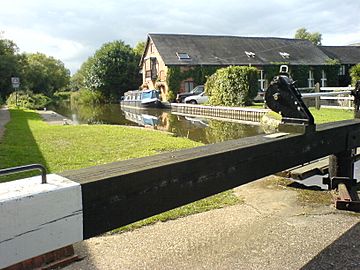Southcote Lock facts for kids

Southcote Lock and Mill from the south bank
|
|
| Waterway | Kennet Navigation (Kennet and Avon Canal) |
|---|---|
| Country | United Kingdom |
| County | Berkshire |
| Maintained by | Canal and River Trust |
| Operation | Manual |
| First built | 1723 |
| Latest built | c. 1970s |
| Fall | 5 feet 3 inches (1.60 m) |
| Distance to River Thames |
3.6 miles (5.8 km) |
| Distance to Bristol Harbour |
90.3 miles (145.3 km) |
| Coordinates | 51°26′10″N 1°00′16″W / 51.436001°N 1.004513°W |
Southcote Lock is a special kind of gate system for boats. It is located on the River Kennet near Reading in Berkshire, England. This lock helps boats move between different water levels. At Southcote Lock, boats can go up or down about 5 feet 3 inches (1.6 meters). It is an important part of the Kennet and Avon Canal.
Contents
How Southcote Lock Was Built
Southcote Lock was built a long time ago, between 1718 and 1723. An engineer named John Hore from Newbury was in charge of building it. This was a big project for its time.
Old Mills and Water Works
Over the years, the area around Southcote Lock became busy. Different buildings were set up to use the river's power.
The Wire Mill
In the 1700s, a wire mill was built near the canal. It was on an island between the canal and the natural river. This mill made wire from iron. It got its iron from a place called Sowley Forge in Hampshire. Two people, Charles Pocock Sr. and Jr., along with Thomas Golden, ran both the mill and the forge. By 1878, the wire mill was no longer used.
The Pumping Station
In 1850, a pumping station was built on the other side of the canal. This station was very important for the town of Reading. It pumped water to the Bath Road Reservoir. This helped provide clean, filtered water to the growing town for the first time.
In 1896, a newer, more powerful steam-powered pumping station opened downstream at Fobney. This meant the Southcote pumping station was not needed as much. Its water wheels and pumps were put away. However, just three years later, the Southcote station was fixed up. New filters and pipes were put in.
Lock Closure and Reopening
In 1952, Southcote Lock was found to be unsafe. Because of this, it had to be closed. Boats could not use it for a while. But by the mid-1970s, the lock was fixed and reopened. This allowed boats to travel on the canal again.
The pumping station kept working until 1982. Then, the Fobney station was made even better to handle all of Reading's water needs. The main building of the Southcote pumping station was then turned into a home. The old wire mill remained empty and unused.

